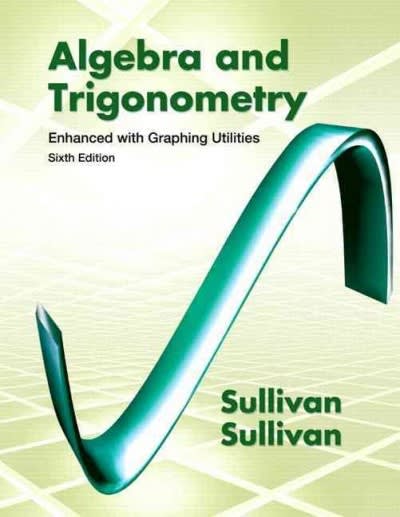

Address the questions below well.the questions are complete.
Question 1
Claims on a portfolio of policies occur according to a Poisson process with a mean rate of 5 claims per day. Claim amounts are 10, 20 or 30. 20% of claims are of amount 10, 70% are of amount 20 and 10% are of amount 30. (i) Calculate the expected waiting time until the first claim of amount 30. [1] (ii) Calculate the probability that there are at least 10 claims during the first 2 days, given that there were exactly 6 claims during the first day. [2] (iii) Calculate the probability that there are at least 2 claims of amount 20 during the first day and at least 3 claims of amount 20 during the first 2 days. [3] (iv) Calculate the conditional variance of the number of claims during the first day, given that there are 2 claims of amount 10 during the first day. [3] [Total 9]Exercise 9.3 A pension plan member is aged 55. One of the plan benefits is a death in service benefit payable on death before age 60. (a) Calculate the probability that the employee dies in service before age 60. (b) Assuming that the death in service benefit is $200 000, and assuming that the death benefit is paid immediately on death, calculate the EPV at age 55 of the death in service benefit. (c) Now assume that the death in service benefit is twice the annual salary rate at death. At age 55 the member's salary rate is $85 000 per year. Assuming that deaths occur evenly throughout the year, estimate the EPV of the death in service benefit. Basis: Service table from Table 9.2. Interest rate 6% per year effective. Salary scale follows Table 9.1; all salary increases occur half-way through the year of age, on average. Exercise 9.4 A new member aged 35 exact, expecting to earn $40 000 in the next 12 months, has just joined a pension plan. The plan provides a pension on age retirement of 1/60th of final pensionable salary for each year of service, with fractions counting proportionately, payable monthly in advance for life. There are no spousal benefits. Final pensionable salary is defined as the average salary over the three years prior to retirement. Members contribute a percentage of salary, the rate depend- ing on age. Those under age 50 contribute 4% and those aged 50 and over contribute 5%. The employer contributes a constant multiple of members' contributions to meet exactly the expected cost of pension benefits. Calculate the multiple needed to meet this new member's age retirement benefits. Assume all contri- butions are paid exactly half-way through the year of age in which they are paid. Basis: Service Table: from Table 9.2 Survival after retirement: Standard Ultimate Survival Model Interest: 4% per year effective Exercise 9.5 (a) A new employee aged 25 joins a DC pension plan. Her starting salary is $40 000 per year. Her salary is assumed to increase continuously at a rate of 7% per year for the first 20 years of her career and 4% per year for the following 15 years. At retirement she is to receive a pension payable monthly in advance, guaranteed for 10 years. She plans to retire at age 60, and she wishes to achieve a replacement ratio of 70% through the pension plan. Using theassumptions below, calculate the level annual contribution rate c (% of salary) that would be required to achieve this replacement ratio. Assumptions: Interest rate 7% per year effective before retirement, 5% per year effective after retirement Survival after retirement follows the Standard Ultimate Survival Model (b) Now assume that this contribution rate is paid, but her salary increases at a rate of 5% throughout her career, and interest is earned at 6% on her contributions, rather than 7%. In addition, at retirement, interest rates have fallen to 4.5% per year. Calculate the replacement ratio achieved using the same mortality assumptions. Exercise 9.6 A pension plan member aged 61 has 35 years of past service at the funding valuation date. His salary in the year to the valuation date was $50 000. The death in service benefit is 10% of salary at death for each year of service. Calculate the value of the accrued death in service benefit and the normal contribution rate for the death in service benefit. Basis: Service table from Table 9.2. Interest rate 6% per year effective. Salary scale follows Table 9.1; all salary increases take place on the valuation date. Projected unit credit funding method. Exercise 9.7 A new company employee is 25 years old. Her company offers a choice of a defined benefit or a defined contribution pension plan. All contributions are paid by the employer, none by the employee. Her starting salary is $50 000 per year. Salaries are assumed to increase at a rate of 5% per year, increasing at each year end. Under the defined benefit plan her final pension is based on the salary received in the year to retirement, using an accrual rate of 1.6% for each year of service. The normal retirement age is 65. The pension is payable monthly in advance for life. Under the defined contribution plan, contributions are deposited into the member's account at a rate of 12% of salary per year. The total accumulated contribution is applied at the normal retirement age to purchase a monthly life annuity-due. (a) Assuming the employee chooses the defined benefit plan and that she stays in employment through to age 65, calculate her projected annual rate of pension











